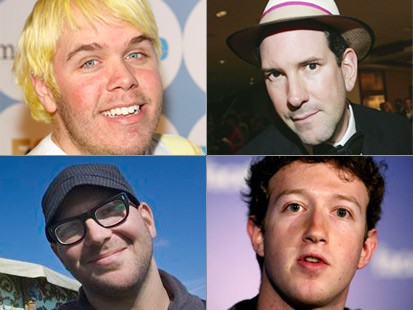Worldwide Pants inks WGA deal
Letterman, Ferguson to return with scribes
BAGHDAD -- The WGA and David Letterman's Worldwide Pants have reached an agreement that will allow "Late Show with David Letterman" and "Late Late Show with Craig Ferguson" to return to the air next week with their writers.Letterman-produced CBS shows will return Wednesday, the same day Jay Leno, Conan O'Brien and Jimmy Kimmel get back to work--without their writers.
Worldwide Pants CEO Rob Burnett said it wasn't tough to make a deal with the WGA. The pact was negotiated by Burnett, longtime Letterman attorneys Jim Jackoway and Alan Wertheimer and WGA leaders including WGA West prexy Patric Verrone and exec director David Young.
"I found the guild straightforward and easy to deal with," he told Daily Variety. "It was a big decision so it took an appropriate amount of time."
The WGA issued a statement Friday confirming the agreement, citing the deal as proof that its demands aren't unreasonable.
"This is a comprehensive agreement that addresses the issues important to writers, particularly new media," the Guild said. "Worldwide Pants has accepted the very same proposals that the Guild was prepared to present to the media conglomerates when they walked out of negotiations on December 7. Today's agreement dramatically illustrates that the Writers Guild wants to put people back to work, and that when a company comes to the table prepared to negotiate seriously a fair and reasonable deal can be reached quickly."
Of course, it helped that Worldwide Pants is a dramatically smaller company than any of the members of the Alliance of Motion Picture and Television Producers and doesn't have nearly as much at stake. Indeed, Letterman is uniquely situated as the 100% owner of his shows -- something even primetime's top players can't claim.
AMPTP discounted the signficance of the deal covering about three dozen scribes in the larger picture of the strike that has idled thousands of working WGA members.
"While it is good news for viewers that the jokes will be back on the late night shows, the biggest joke of all appears to be the one the WGA's organizers are pulling on working writers," the AMPTP said in a statement. "The people in charge at WGA have insisted on increasing their own power by prevailing on jurisdictional issues such as reality, animation and sympathy strikes. Yet today the WGA made an interim agreement to send writers back to work that by definition could not have achieved these jurisdictional goals -- gains that would at a minimum require the company making an agreement to actually produce reality and animation programming."
AMPTP also said that guild was "misrepresenting" Worldwide Pants' status as an AMPTP member, though the production banner's Worldwide Trousers Inc. corporate entity was included on the list of struck companies posted on the WGA West's website.
Moreover, a deal that allows CBS' latenight block to return also affords the guild a way to turn up the pressure on rival nets, particularly NBC. Peacock's profitable latenighters, "The Tonight Show with Jay Leno" and "Late Night with Conan O'Brien" could be at a competitive advantage without writers, and if A-list SAG members don't have to cross picket lines to do Letterman and Ferguson's shows.
Worldwide Pants reached out to the WGA for an interim agreement shortly after the strike began on Nov. 5. The guild only recently engaged in talks with the company, after making the strategic decision to seek individual talks with AMPTP members. And even then, it had been thought that WWP wouldn't be able to cut a deal because CBS controls the new media rights to Letterman's shows. However, as the studio that produces the shows, WWP "is responsible for paying residuals to our writers" for Internet use of said shows, Burnett said.
Eye drew just such a distinction in a statement it issued Friday night.
"CBS controls the Internet exploitation rights for both programs, and will comply with any eventual negotiated agreement between the AMPTP and the WGA," it said.
Guild said that WWP agreed to the new media terms it was preparing to offer as a counter-proposal to the majors on Dec. 7, the day the most recent round of negotiations broke down. The specifics of the new media residual formulas that WWP agreed to were not immediately clear late Friday, nor was it clear whether the WWP included a "favored nations" clause that would allow the company to alter its contract should the WGA cut a contract deal at more favorable terms with the major studios.
WGA reps did not immediately respond to requests for more detailed info about the new media formula. In its previous counterproposal to the majors, the guild was understood to have proposed a residual for Internet streaming of full-length episodes that would be based on a percentage of the existing broadcast minimum, to be paid again after every 100,000 views of an episode. The AMPTP's most recent proposal, by contrast, offered a percentage-based residual for a year's worth of web streaming that worked out to about $250 for an hourlong episode.
It's understood that Worldwide Pants even agreed to the guild's points on jurisdiction for reality and animation production - which have been lightning rods in the guild's talks with studios. For Worldwide Pants, that's likely to be a negligible commitment given its lack of activity in the reality or animation genres to date.
Burnett said he would leave it to the WGA to discuss deal specifics.
"In the broad strokes, I will say that Worldwide Pants has always been a very writer-friendly company," Burnett said. "We had no problem agreeing to the demands the WGA has on the time."
WGA's decision to strike a deal with Letterman no doubt irked the hosts of the other latenight shows set to return to work in January, all of whom are also WGA members. However, unlike Letterman, hosts such as Leno, and Jon Stewart don't own their shows and therefore are at the mercy of the studios that do produce their skeins.
In a letter to members, WGA leaders recognized that the deal with Letterman meant that some latenight scribes would be returning to work next week, while others would remain on the picket lines. But it said the Letterman deal was a necessary part of the guild's broader bid to increase pressure on the majors by negotiating with individual companies.
"Companies who have a WGA deal and guild writers will have a clear advantage. Companies that do not will increasingly find themselves at a competitive disadvantage," the guild wrote.
WGA also made it clear that it doesn't matter that Leno and the other hosts can't negotiate their own deals like Letterman did. Their shows will now be key to the WGA's strike strategy.
"Our strike pressure will be intense and essential in directing political and SAG-member guests to Letterman and Ferguson rather than to struck talk shows," the WGA, saying picket lines in front of the NBC shows "are essential."
To underscore the notion that it's OK for stars to do Letterman but not Leno, SAG topper Alan Rosenberg issued a statement hailing the deal with Letterman's company.
"We hope this encourages all of the talk shows to follow suit and use only WGA writers," he said. "Screen Actors Guild members will be happy to appear on 'The Late Show with David Letterman' and 'Late Late Show with Craig Ferguson' with union writers at work and without crossing WGA picket lines."
Burnett conceded that WWP-produced shows will now have a competitive advantage, both in booking guests and in producing funny content.
"But I'd give it up in a second if it meant everyone could come back to work," he said. "What we want is for the thousands of writers who are out of work to be back at work.
"This is really about something much bigger than these shows and the competitive advantage we obviously get," Burnett added. "This is about the strike and people on the picket lines. The Guild has been very responsible in weighing the pain of the strike versus the future well-being of the membership."
For the producers of the other shows, however, the deal was a major headache.
Guest lists for next week's original shows have been a closely-guarded secret, no doubt because producers don't want to scare off celebs from appearing on struck shows. But the WGA and SAG missives Friday will increase pressure on celebs to stay away from latenight skeins not owned by Letterman.
The WGA called on Leno's Peacock employers to get back to the bargaining table.
"It's time for NBC Universal to step up to the plate and negotiate a company-wide deal that will put Jay Leno, who has supported our cause from the beginning, back on the air with his writers," it said.
Talks between WWP and the WGA weren't looking fruitful earlier this week. But that changed within the last 48 hours.
Before that, "We did not have any firm indication that this was going to transpire," Burnett said, though he emphasized that earlier talks between WWP and the WGA had been productive.
Burnett said he had tried to strike a deal with the WGA the moment the strike began. At the time, the Guild said it didn't think such a deal would be to its advantage.
But when the WGA announced plans to begin direct negotiations with companies, "We wanted to be the first in line," Burnett said.






















